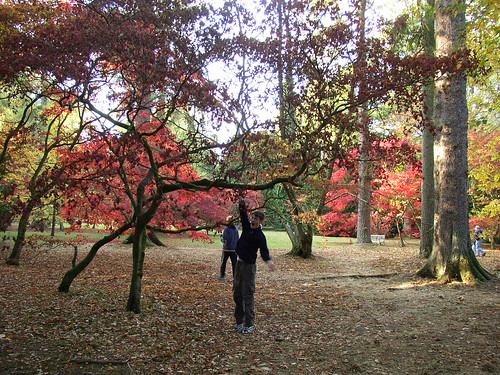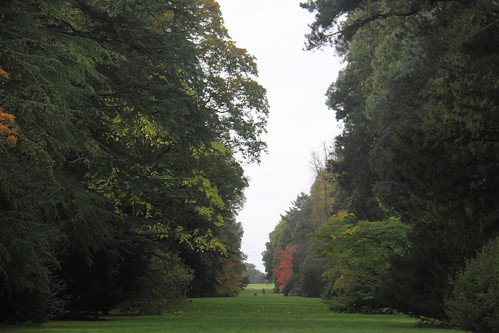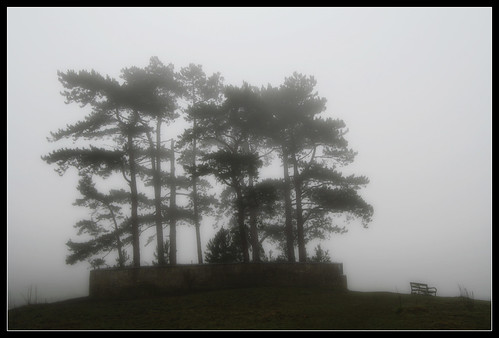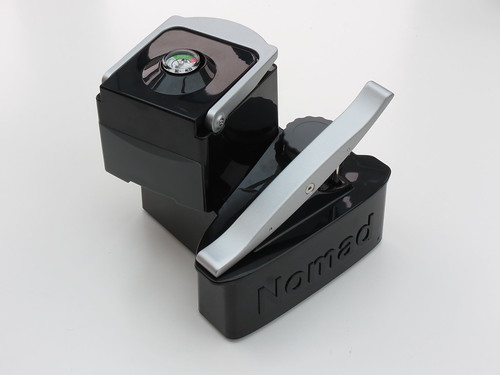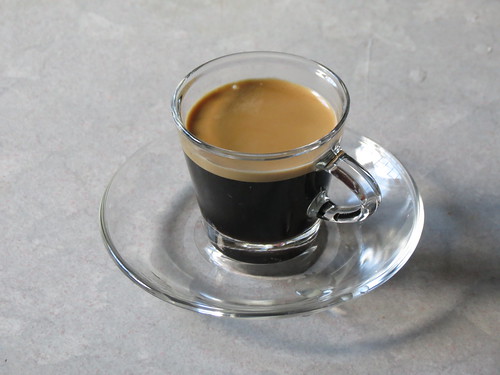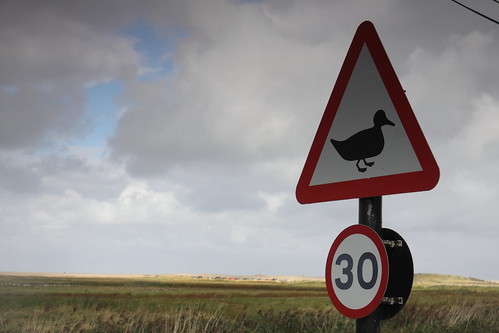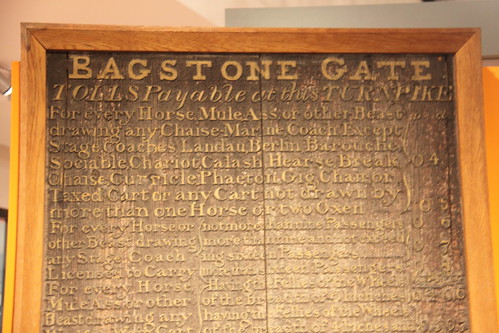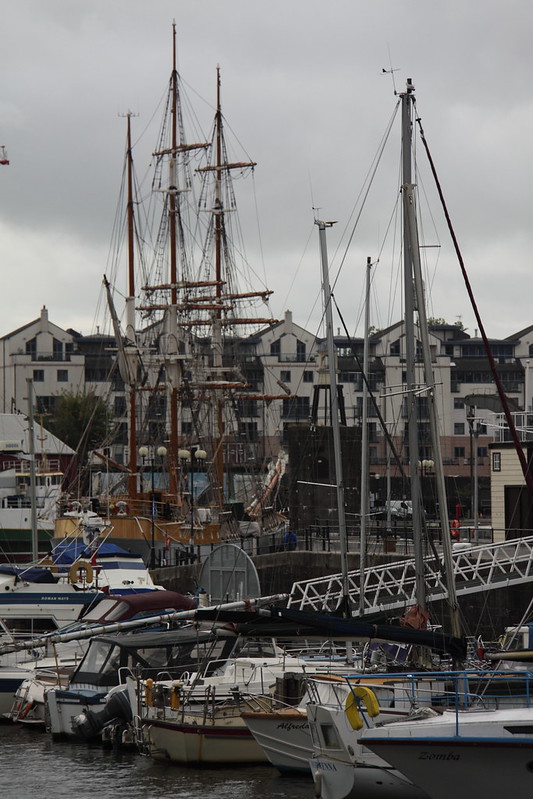When I drove back from Thornbury this morning the temperature outside, according to the car, was 18°C (64°F). It's still t-shirt weather outside, and it feels more like late August than the last day of October. In Gravesend the Met Office recorded a temperature of 23.5°C (74.3°F). That makes this the warmest Halloween on record, and by a considerable margin, too. Even though the Sun sets in quarter of an hour, it's still 17°C outside as I type this. I suspect things are about to change, though. The forecast for the middle of next week onwards is for more seasonal temperatures.
I love the fact that I can make a throwaway comment like "the forecast for next week" these days and have it mean something. Even vaguely accurate forecasts for a week ahead were pretty much unheard of when I was a kid, but climate modelling is far more sophisticated nowadays, no least because the amount of computing power available to forecasters is immense. And forecast power gets greater every year - as evidenced by the new machine the Met Office will be commissioning in 2015: it's a Cray XC40 supercluster with a mind-boggling 480,000 processor cores that will run 13 times faster than the Met Office's present system. The current forecast resolution of 12 km will increase to just 1.5 km on the new system, with limited-area detailed runs providing a resolution as fine as 300 metres. One research project in development is intended to model cloud coverage from 50 metres down to just two metres!
It's the first day of November tomorrow. That means Nanowrimo is upon us once more and I will try to write a 50,000-word novel by the end of the month.
Now that is a scary thought for Halloween!
I was very sorry to hear that Jack Bruce died this week. He's been a hero of mine for many years, a true bass player's bass player. Aside from handling the low end in the original rock supergroup Cream, he was also their singer, and he was a bloody good one. Just doing that was enough to earn him legendary status, but he kept at it. He was in Tony Williams's Lifetime with John McLaughlin; he formed a power trio with Corky Laing and Leslie West (both of Mountain fame); he appeared on Frank Zappa's album Apostrophe; he recorded a couple of albums with Robin Trower. When he appeared on two tracks on Allan Holdsworth's legendary Road Games project, I decided that he could do no wrong for me; after all, not only was he equally at home with a fretless or fretted bass, he was also a Stick player.
Jack Bruce was one of few musicians that non-musicians have heard of, particularly after a new recording of I Feel Free was used for the advertising campaign for the Renault 21 back in 1986 (I still have the 7" single). He pushed the boundaries of the bass, he was part of one of the biggest bands in the history of rock, and he was a huge influence on other musicians, many of whom have been posting about his passing this week. We've lost one of the true greats of rock music.
Last night I fired up the streaming video feed from NASA's Wallops launch facility to watch the launch of an unmanned Antares spacecraft which was taking the Cygnus cargo module to the International Space Station. With fast broadband, the picture quality was excellent. So I saw what happened as the rocket left the pad in spectacular detail: there was an explosion at the base of the rocket, it dropped back to the pad, and the whole thing went up in flames. The explosion was large enough to be picked up by the local doppler radar installation. Thankfully there are no reports of any injuries to personnel.
So what happened? The explosion happened just as the rocket motors were ramped up to 108% thrust (it's an engineering thing; a rocket operating at 100% of its normal power output is said to be operating at rated power, while "full power" is set at 104% and is nowhere near the maximum output of the engines; the Shuttle main engines - which were human-rated, remember - could be pushed to 109%) and on video the failure occurs somewhere at the base of the spacecraft. Harvard astronomer Jonathan McDowell pointed out fairly rapidly last night that the Antares uses refurbished Russian NK-33 engines left over from the Soviet lunar programme, so I'd say that the finger of blame is pointing fairly strongly at the motors right now. As some components are likely to be the best part of fifty years old, if that turns out to be what happened I won't be particularly surprised.
This is the first time the Antares system has failed. It's a shame, but as Commander Chris Hadfield pointed out last night, spaceflight is hard. Media coverage recently gives the impression that "getting to space" can be as easy as hanging under a balloon for a couple of hours, but as we saw this week, once you let go of the balloon you drop straight back to the ground. True spaceflight requires speed, and lots of it. Just getting to Low Earth Orbit (LEO) and meeting up with the ISS means riding something that's capable of accelerating to 7.8 km a second (that's a shade under 17,500 miles per hour in old money) and while getting above the atmosphere reduces air resistance, it's not the moving upwards that's the important bit. To achieve orbit you need to be moving so that the curvature of the Earth drops away from you just as fast as you fall towards it. To do that, you need to be moving sideways. Very fast.
To do all that means unleashing spectacular amounts of energy in a very short amount of time. Each Antares motor is providing 1,505 kN (338,000 lb) of thrust by burning kerosene that's stored in a pressurised tank and to stop them melting, the motors have to be cooled with liquid oxygen stored in another pressurised tank. Aside from just the mechanical stresses involved, liquid oxygen and hot things can be an interesting combination. The Antares has two of these motors running simultaneously. A spacecraft is not something you want to be sitting on if there's even the remotest chance of mechanical failure. Spaceflight remains a risky business, and events such as those that happened yesterday serve to remind us just how risky it can be.
Judith Newman's 13-year-old son is autistic, but his best friend teaches him about the niceties of human interactions, helping him to learn about saying "please" and "thank you", to understand the value of saying nice things to people, and she tirelessly searches for the answers to his questions about the world. She's never judgmental, and never loses patience with him. Gus's best friend is Siri.
If, like me, you watch a lot of science fiction movies, you've probably spent some time wondering what a black hole would look like up close in real life. They've been portrayed in many films, and yet we never get an impression of how the phenomenal energy output, the gravitational distortion, the accretion disk and all sorts of other phenomena would actually appear from close by. I always found the Disney version of things particularly disappointing. But the more I hear about Christopher Nolan's new film Interstellar, the more interested I become, because he got the physicist Kip Thorne (yes, that Kip Thorne) to give his special effects team the equations and data they needed to render an accurate image of what it would look like if your spaceship found itself next to a real black hole. The results are strangely beautiful and, says Thorne, good enough to be taken as observational data. Good enough, in fact, that he'll be writing at least two research papers based on the work. And that really is darn spiffy, if you ask me.
I didn't really appreciate how fast my broadband connection was until yesterday, when I decided to download every episode of the Welcome to Night Vale podcast. It took me around six minutes.
First thing this morning I ran a speed test on my line, and got this. Pretty dismal, eh?
But after the BT Openreach engineer paid a visit this morning, things have changed. In fact they have changed so much that the old speedchecker site I was using couldn't handle it - so here's a screen capture from the Think Broadband site instead...
I'm now using Fibre To The Cabinet (FTTC) for accessing the Internet. As you can see, there has been a considerable increase in speed. In fact, it's more than 24,000 times the speed I would achieve with the 2800 baud modem I used to access the Internet back when I first moved here. "Oh, that'll go up. You'll easily get 70 meg," Paul the engineer said. Not surprisingly, I'm sitting here with an enormous goofy grin on my face.
Rebecca came to visit last weekend and on Saturday we paid a visit to Westonbirt Arboretum. It's been a while since we last went there. In fact it was October 2003 when we took the twins for a walk amongst the trees and we found ourselves walking amongst the Forestry Commission's spectacular collection of Japanese maples...
Rob and Ruth have done a huge amount of growing up since then and this time it was just Becs and me, but digital camera technology and - I think - my skills as a photographer have developed somewhat over the last eleven years...
The majority of trees in the arboretum still had green leaves; it was the maples that were providing all the spectacle. But that didn't matter - it was a very nice way to spend the afternoon and despite the fact that it's the busiest time of year for Westonbirt, the woods didn't seem at all crowded. In fact Rebecca and I found ourselves wondering where all the people that must have been in the cars in the car park had disappeared to...
If you're in the area Westonbirt is well worth a visit.
British Summer Time ended in the small hours of the morning. I've done one sweep of the house so far changing clocks back to Greenwich Mean Time and when I've finished writing the blog I'll be changing the clocks on my cameras. These days I seem to have a ridiculous number of devices that do their own timekeeping: I've had to set synthesisers, game consoles, multi-track recorders, microwaves and ovens, for a start - but few of them are clever enough to figure out that the clocks have gone back. Meanwhile, in Russia they've decided they'll permanently stick with winter time. I don't blame them.
The blog hasn't been updated for a few days because for the fisrst time in several months I've found myself busy with work. I spent last week teaching at UWE as an external consultant or "adjunct instructor" and I had an absolute blast.
Despite blogging last time that I'd switched the heating on, a couple of days later I'd switched it back off again. The weather has been remarkably mild for the last week, and right now at just after 10 am it's currently 14°C outside. There still hasn't been a frost so far this autumn, either. Yesterday I didn't even need a jumper on, just a t-shirt. No wonder the leaves are still green on a lot of the trees.
It was so cold and damp on Sunday that I caved in and put the heating on. I've set the system so it comes on for half an hour in the morning and half an hour at the end of the evening. And since then, I've had two of the best nights' sleep I've had for weeks. I suspect that being warm was only one reason, though; the fact that it no longer gets light at five o'clock in the morning has a lot to do with it as well. Sunrise this morning was at 7:32 am, and nautical twilight didn't start until 6:19 am. I didn't wake up until the room started to get light at around 7. That's much better than half past three, which is what I was doing in the summer, even with a blackout blind on the window. The current advice for restful sleep recommends keeping your room so dark that you can't see across it with the lights off, and that's what I do, but in the summer I struggle. I like the whole house to be dark when I'm asleep. I couldn't be more different to my father, who leaves the hall light and the porch light on all night; I seldom sleep well when I visit him.
Despite whingeing about cold and damp, this is my favourite time of year. Misty mornings turn an interesting photographic subject into a great one, for a start.
When the weather closes in, there's no guilt involved in wanting to sit inside and read a book. It's nice to have the fire going. It's the time of year for curries, casseroles, and stews. And there's mulled wine to be drunk. Yes, autumn is here, and I'm enjoying it.
I've had to postpone switching to FTTC for a week as I'm working but I should be up and running with superfast broadband before the end of the month. BT have to fit a modem, then I plug my existing router into it, change a couple of login parameters, and (with luck) away we go. At present even loading a web page with lots of pictures on it is painfully slow, so I'm hoping I will notice a huge difference.
Given that I'm currently getting just 1250 kb/s over ADSL right now, I think there's every chance that I will. Broadband has never been great here, but things have degraded tremendously over the last couple of years. Back in October 2012 I was getting nearly double my current speed, at 2380 kb/s. Speeds haven't been this bad since back in 2009.
You know that song "Everything is Awesome" in the Lego movie? It's satire, kids. It's taking the piss. It's not meant to be taken literally. But on the Internet, it might as well be the national sodding anthem. I am really, really, really, really, REALLY absolutely sick to the back teeth with web stories that have a strapline that is one variant or another of "what happened next was unbelievable." The web has a real problem with formulaic, brainless and uninspired writing at the moment. Site after site has adopted the approach. To me, it's a signal that whoever put the page together had no confidence that what they wrote would attract readers on its own merit. The claim that something is "unbelievable" also suggests to me that the writer hasn't got the imagination or intellectual capability to visualise anything out of the ordinary ever taking place. Which is why, if a writer doesn't think their stuff is good enough to read without hyping it up, I'll take their word for it. I'll tell you exactly what happened next for all those "unbelievable" stories: they went unread.
I want to see more honesty in my web pages and less exaggeration and hyperbole. Let's have people using litotes for a change, like Doug Piranha. I want to read the occasional story about something that was regarded as "nothing special, but it was all right I suppose." A product review that reassures me it's "not a complete waste of money." A gig that was just "okay." Give me something I can believe.
The twins are 25 years old today. Happy birthday to Ruth and Rob!
This week I dipped my toes into the waters of academia for the first time, and so far I'm really enjoying it. I must admit that if you'd told me this time last year that I'd be describing myself with the words "adjunct faculty" I wouldn't have believed you, but here we are. And where am I working? It's quite literally over the road from my last place of employment.
I have just placed an order with my ISP to upgrade to superfast broadband. Yes, BT Openreach have just changed the status of Cabinet 6 on Little Bristol Lane to "accepting orders"!
Yesterday my Kickstarter Edition of Uniterra's Nomad espresso machine arrived. It is a thing of rare beauty...
And just as importantly, the espresso that it produces is the business:
I'm delighted with it. I am going to have to watch myself, though, as it produces a double shot of espresso rather than a single shot, and yesterday when I tried it out I'd already had a large mug of latté in the morning. This might have been why I was still awake at two o'clock this morning.
"But Chris," I hear you ask. "Why have you bought another espresso machine when you already have a lovely Rancilio Sylvia?" I'm glad you asked me that. The simple answer is that the Nomad is a go-anywhere espresso machine. It's portable. So it means if I go over to see my father, for whom coffee only comes in glass jars, I can take the Nomad with me and keep my caffeine levels stable and elevated. All I need is a kettle for boiling the water. It's pretty much a no-brainer.
When I'm at home for the day, my morning routine begins with the rituals of coffee making. They've been a part of my life for many years, and last year for 50/90 I even wrote a song to commemorate them. Frothing the milk is part of the process that absolutely fascinates me, because the results can vary so much. Firstly, the milk stretches - that is, it increases in volume. The amount by which the volume grows is a massively variable factor all by itself (and I still remember one team in The Apprentice crashing out of the programme a few years ago because they didn't know about the phenomenon and bought way too much milk!) Then the milk heats up - and there's a fairly small margin in which the milk will be at the right temperature for coffee. Too cold, and your coffee will be lukewarm. Too hot, and the proteins in the milk start doing weird things which turn the milk into something resembling a soggy meringue, which will ruin your coffee experience. Some of the real coffee diehards claim that even fluctuations in mains voltage will affect your end results!
The idea is to turn the milk into something called microfoam without overheating it or blowing it up. As its name suggests, in microfoam the bubbles are too small to see. The foam should not be stiff, but instead should flow like a liquid. It should stay that way while you drink your coffee, too; the bubbles should be small enough to stay suspended in the milk rather than rising to the top and the chemistry that's going on mentioned in those links above helps to keep the bubbles in suspension. Because the hydrophilic and hydrophobic molecules are fat molecules, it's easier to make good microfoam with full-fat milk than it is with skimmed milk, and that is the reason I've switched back to it from skimmed milk (and, it has to be said, I feel much better and fitter for doing so). I've noticed that milk from some suppliers is far better than others for getting decent foam; Waitrose milk is particularly good, and that's what I'm using this week. Which might be why, this morning, I managed the closest I've ever got to my goal of decent microfoam...
As soon as I poured it into the cup I knew I had to take a photo, because yes I'm sad and have no life. But it tasted as good as it looked.
Well, not really. But getting this photo retweeted by BBC Springwatch on Friday meant one of my tweets getting a fair amount of exposure: the count right now is 38 retweets and 80 favourites, which is, to my knowledge, the widest exposure I've ever managed on Twitter.
I must admit to getting more than a little misty-eyed to see William Shatner and Leonard Nimoy on screen together once again, even if it is for an advert for Volkswagen cars.
Mr Nimoy is driving Volkswagen's two-seater XL-1 concept car. It delivers an incredible 261 miles per gallon and VW are, apparently, going to make a production version.
Microsoft have announced that the next version of their operating system will be called Windows 10. No details on when they'll be releasing it just yet, but they seem to have accepted that the radical change in user interface design in Windows 8 was just too different to be accepted my the majority of users (and it has to be said, I hated it); a lot of the things that Windows 8 dropped appear to be coming back. The most frequent question people have been asking since the announcement, though, is "What happened to Windows 9?"
Sam at Things of Interest found the most likely explanation, and it's prosaic enough to be true: software often checks to see what operating system it's running under, and many programs would assume that if the OS returns a text string that begins "Windows 9" then the OS in question would be either Windows 95 or Windows 98. Yeah, I guess you wouldn't want your shiny, new latest-and-greatest product to be confused with a product that's 20 years old, really. Especially given that back in the days of Windows 95, tech like USB sticks didn't exist...
I had the car serviced today, so after dropping it off at the dealership I walked into Bristol. I'd decided I'd risk not wearing a coat, as it was very warm - that paid off, as although there were a few spots of rain I didn't get wet at all. Just as well, too. I'd have melted in a coat, for the weather is still unseasonably warm. In fact it's been the driest, and one of the warmest Septembers on record.
I walked alongside the River Frome on the way into town, and I kept an eye on the river, just in case. Despite the occasional shopping trolley and beer can it was teeming with fish and there were dragonflies hunting over the water. I had a feeling I might see something interesting, and I did; as I got to Staples, there was a flash of blue, a whirr of wings, and a kingfisher blurred past me and disappeared into the undergrowth on the opposite bank. The centre of one of Britain's largest cities is not somewhere you'd expect to see such a lovely sight, but it brightened up my whole day.
I wasn't intending to do much shopping today; without access to the car I didn't want to be lugging much stuff about. That's probably just as well, as I discovered a very nice looking Ibanez 9-string guitar on sale in PMT at a very tempting price...
Instead, I had my camera with me. And I was glad of it, too, as by the cranes on the harbour there was something interesting going on. The place was buzzing with activity. A lovely old British Road Services lorry loaded with a very interesting selection of cargo was parked near the last of the cranes and there were lots of people milling around with lanyards and film cameras.
I returned to the M Shed, which I'd visited last month with Adrian and Peter. I wanted to have a more in-depth look at the ground floor exhibits, which tell the history of Bristol's different areas from Clifton and Hotwells to Bedminster, from Sea Mills to Westbury. I learnt a lot about this city that I didn't know, such as the fact that Bristol even had its own rather splendid style of architecture known as Bristol Byzantine. I also discovered that the road from Bristol to Wotton-Under-Edge that runs through my village used to be a toll road further south, in Bagstone. The M Shed has the beautifully carved board which sets out the tolls for vehicles using the road. Chariots, fourpence please.
It's weird, but all day I had to keep reminding myself that I wasn't in a rush to get anywhere and that I could slow down and take my time. Maybe I shouldn't have started the day with quite as large a mug of coffee as I did... I did stop on Pero's Bridge to take photos of the bewildering array of masts on view in the harbour, though.
I walked up Park Street so I could call in at Forbidden Planet and was delighted to see that Ancillary Sword, Ann Leckie's follow up to Ancillary Justice (which has won just about every award in SF this year) was on sale. It's not supposed to come out until next week, but that wasn't going to stop me grabbing a copy. Tonight I've already read four chapters and things are really kicking off; it's a fine sequel. I also picked up the next two books in Richard Kadrey's Sandman Slim series for good measure. By now the garage had rung me to say that the car was ready to collect, so after grabbing a bite to eat in Cabot Circus I walked back to the garage, picked up my freshly-washed car and drove home.
I spent the rest of the afternoon doing some gardening. From the weather forecasts I've seen in the last day or so I didn't think I'd get much of a chance to mow the lawn at the weekend, so it seemed the easiest thing to do. By the time I'd finished, though, I was drenched in sweat, my feet hurt, and I could barely walk. All I felt like doing was soaking in the bath. One problem: no hot water! Argh. Don't know what happened there...



